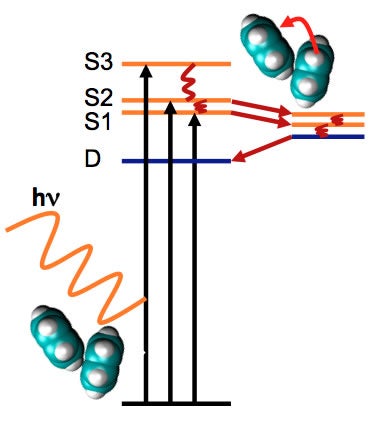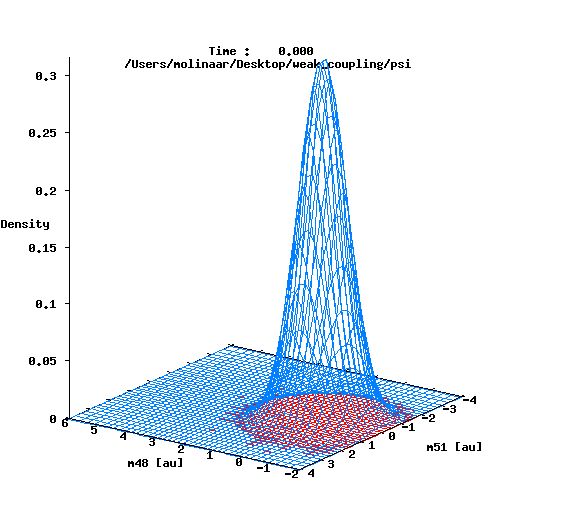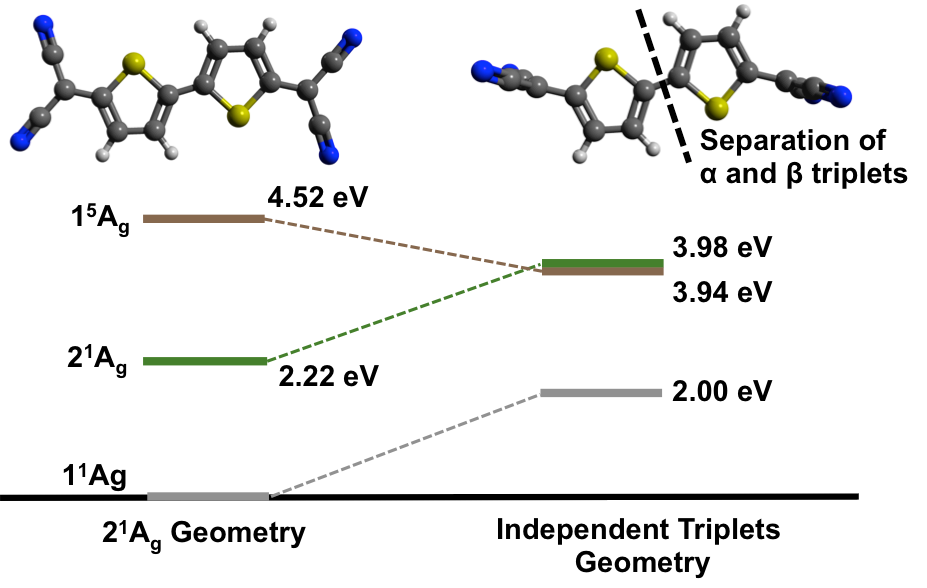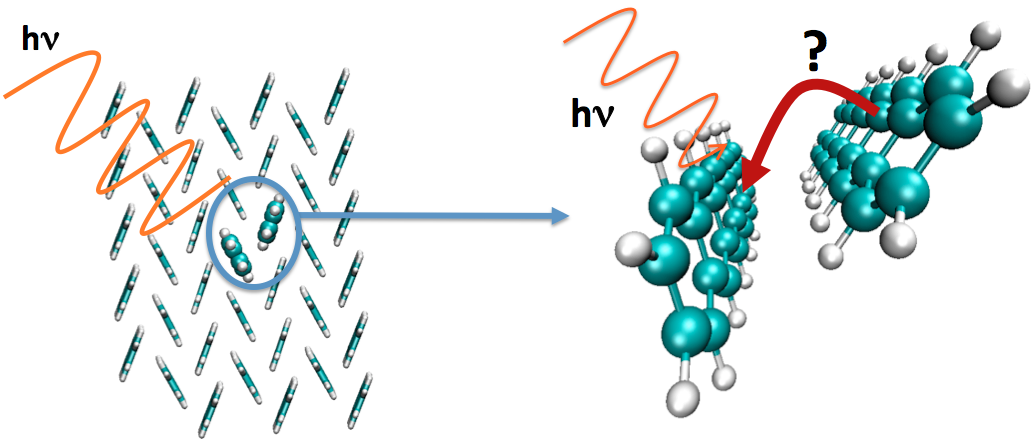Introduction
Organic solar cells hold incredible promise as potential technologies for energy sustainability and independence. These could be produced in mass at low cost due to the flexibility of the materials, and therefore would be dramatic improvements over existing inflexible, high processing cost inorganic solar cells. Currently, organic solar cells are typically much less efficient in converting sunlight into useable power compared to inorganic cells. Key developments that might dramatically increase the efficiency of organic cells are therefore at the forefront of our research.
Singlet Fission
In pentacene crystals, it is well-known that optically-accessible excitonic (electron-hole pair) excited states undergo rapid conversion to create two triplet excitons. This phenonmenal process could be exploited in solar cells by down-converting high energy photons into multiple charge carriers, which in turn increases the electrical current of the cell. This process is the organic analogue of multiple exciton generation and is called “Singlet Fission.” Without a fundamental description of the mechanism for charge multiplication, however, progress has been limited in applying singlet fission to enhancing solar cell efficiency.
Models for Excited State Behavior
The above figure shows a model for describing the photo physical behavior of a pentacene crystal. In this system, an atomistic description of the molecular crystal allows a detailed description of the response to absorbing a photon. In particular, electronic states are described using the new “Restricted Active Space Spin Flip” method, which allows both single and multi-exciton states to be simulated (a great improvement over TD-DFT, which cannot simulate multi-exciton states). To fully describe this process, nuclear-electronic coupling must be accounted for as well as molecular interactions in the crystal. Therefore a hybrid “Quantum Mechanics/Molecular Mechanics,” or QM/MM, approach is needed that accounts for quantum descriptions of electronic states as well as crystal strain. Full details of these approaches can be found in the references below.
Mechanism for Singlet Fission
 The mechanism for singlet fission in pentacene can be explained by considering that population transfer between two electronic states is maximized when the two states are close together in energy. This behavior is a manifestation of a breakdown in the Born-Oppenheimer approximation, which is otherwise valid when electronic states are separated by large energy gaps.
The mechanism for singlet fission in pentacene can be explained by considering that population transfer between two electronic states is maximized when the two states are close together in energy. This behavior is a manifestation of a breakdown in the Born-Oppenheimer approximation, which is otherwise valid when electronic states are separated by large energy gaps.
The primary states involved in singlet fission are the optically-allowed excitons, denoted S1, S2, etc, and the optically-dark double triplet exciton state (D). Because near-degeneracy between S and D states will enable population transfer, a search for the mechanism of singlet fission is analogous to a search for the nuclear motions that bring S and D close together in energy.
We discovered that changes in the π-π overlap between neighboring pentacene monomers was the most likely coordinate driving fission. The schematic on the right shows how this might occur: 1. first a photon is absorbed, yielding an S state, 2. intermolecular motion changes the relative energies of the two states, 3. at nearly degenerate positions, population rapidly transfers from S to D, and 4. D relaxes to its equilibrium position. At stage 4, fission has occurred and two (spin singlet coupled) triplets have been formed. Singlet fission in this material occurs on an ultrafast sub-ps timescale, making this mechanism highly suitable for transfer to other materials to enhance solar cell efficiency.
Intramolecular Singlet Fission
While intermolecular singlet fission is well-known, intr amolecular singlet fission is less well understood. The Goodson group at the University of Michigan has found experimental evidence that a quinoidal bithiophene (QOT2) may effect intramolecular singlet fission. Specifically, a long-lived photo excited state was observed, which showed excited state absorbance properties resembling a double triplet. Similar to pentacene, a near-degeneracy between two excited state surfaces plays an integral role in QOT2’s exciton dynamics, enabling the initially excited S1 state to rapidly transition to a dark state (see Figure to right). The dark state was characterized by Restricted Active Space Spin Flip computations as being composed of two strongly coupled triplets. Decoupling these triplets (Figure below) costs roughly 1.7 eV – much more energy than is thermally available at room temperature (0.026 eV). Thus, separation of triplets within QOT2 appears infeasible.
amolecular singlet fission is less well understood. The Goodson group at the University of Michigan has found experimental evidence that a quinoidal bithiophene (QOT2) may effect intramolecular singlet fission. Specifically, a long-lived photo excited state was observed, which showed excited state absorbance properties resembling a double triplet. Similar to pentacene, a near-degeneracy between two excited state surfaces plays an integral role in QOT2’s exciton dynamics, enabling the initially excited S1 state to rapidly transition to a dark state (see Figure to right). The dark state was characterized by Restricted Active Space Spin Flip computations as being composed of two strongly coupled triplets. Decoupling these triplets (Figure below) costs roughly 1.7 eV – much more energy than is thermally available at room temperature (0.026 eV). Thus, separation of triplets within QOT2 appears infeasible.
A viable mechanism for triplet decoupling is key for the completion of intramolecular singlet fission. Subsequent studies on how to best harvest the coupled triplets in QOT2 are underway.
Recent solar related publications:
1. H. Kim, B. Keller, R. Ho-Wu, N. Abeyasinghe, R. J. Vazquez, T. Goodson III, P. M. Zimmerman, “Enacting Two-Electron Transfer from a TT state of Intramolecular Singlet Fission,” J. Am. Chem. Soc., 140, 7760–7763 (2018).
2. H. Kim, P. M. Zimmerman, “The Coupled Double Triplet State in Singlet Fission,” Phys. Chem. Chem. Phys., 20, 30083-30094 (2018).
3. R. Vazquez, H. Kim, P. M. Zimmerman, T. Goodson, III, “Using ultra-fast spectroscopy to probe the excited state dynamics of a reported highly efficient thermally activated delayed fluorescence chromophore,” J. Mat. Chem. C, 7, 4210-4221 (2019).
4. A. D. Chien, A. R. Molina, N. Abeyasinghe, O. Varnavski, T. Goodson, III, P. M. Zimmerman, “Formation, Identification and Evolution of a 1(TT) State in a Quinoidal Bithiophene: Characterizing a Promising Intramolecular Singlet Fission Candidate,” J. Phys. Chem. C, 119(51), 28258-28268 (2015).
5. P. M. Zimmerman, F. Bell, D. Casanova, M. Head-Gordon, “Mechanism for singlet fission in tetracene and pentacene: from single exciton to two triplets,” J. Am. Chem. Soc., 133, 19944-19952 (2011).


